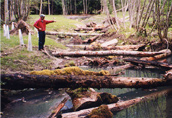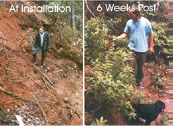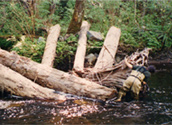 Riparian Restoration
Riparian Restoration
Riparian restoration targets function. Proper functioning riparian areas provide stream shading, surface runoff filtration, bank stability, wood debris recruitment, floodplain capacity, and more. Preparation of micro sites for planting, seasonal collection and planting of site specific species, preparation and installation of wildlife trees and nesting trees, and establishment of groundcover with pioneer species are all facets of riparian rehabilitation aimed to restore individual functions. The positive effect of a healthy riparian zone on stream hydrology and hydraulics directly affects local stream productivity.
 Bioengineering for slope and bank stabilization
Bioengineering for slope and bank stabilization
Bioengineering provides a low impact method of slope and bank stabilization where using rock or concrete is difficult or undesirable. Use of native plants, and techniques such as facines, livepole drains, wattle fences, modified brush layers, and staking, provide cost effective soil drainage and stabilization thus reducing sediment delivery to a watercourse. Use of pioneering plants for quick ground cover is complemented by the planting of later maturing successional vegetation that will ultimately compose the mature plant community. Labour intensive but cost effective, these methods can be employed in locations where machinery use is not desired, permitted, or feasible. It is particularly effective in areas where ground water comes to the surface causing chronic erosion problems.
 Fish Habitat Rehabilitation
Fish Habitat Rehabilitation
Whether a stream is 1 meter or 31 meters wide, East Coast Aquatics can provide prescriptions to improve the fish habitat by reducing limiting factors to production. If the objective is to rehabilitate or mitigate the impacts associated with a current
development, or improve the productive capacity of a system that has seen cumulative impacts over the last 100 years, a number of proven techniques can be employed to re-establish stream processes, stability, and fish habitat value. Large wood debris structures such as bank revetments, debris catchers, and A-frames may be appropriate where natural large wood recruitment has been impacted. Rock riffles, boulder clusters, and deflectors are additional methods that are used to meet target objectives of establishing meander sequence, thalweg definition, riffle-pool sequences, gravel recruitment, and pool formation. East Coast Aquatics can provide detailed prescriptions with site drawings, as well as experienced staff to implement approved stream works. Structures are designed for the client’s various aesthetic and stability objectives by applying appropriate ballasting and anchoring techniques to compensate for buoyancy and drag associated with the annual flood return.

